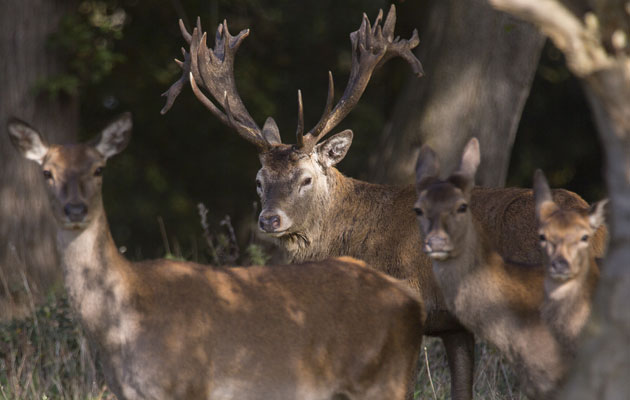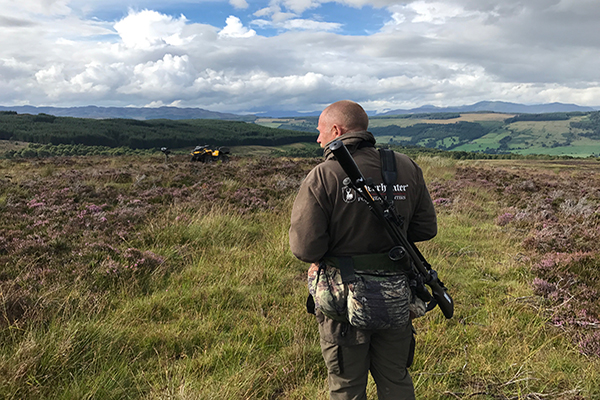Win CENS ProFlex DX5 earplugs worth £1,149 – enter here
Deer management: GBSA winner Chris Dalton’s real-world guide

One of things I am constantly being asked about, by both experienced and inexperienced stalkers and, surprisingly, non-stalking B&B guests at Garryloop, is what exactly deer management involves. Now that’s a pretty wide ranging question, but as a primer I thought it would be useful to look at the sort of decisions I have been making in the first couple of years of my management of Kinnaird Estate in Perth and Kinross – specifically, the considerations in starting to formulate a long-term deer management plan (DMP).
Clearly there are many factors that influence a deer management plan, the most important being the requirements of the estate owner. He or she ultimately drives this. At Kinnaird, I consider myself fortunate to have an owner who lives on the estate, is very proactive in what goes on, and is prepared to listen to the various specialists he has gathered to offer suggestions within their particular areas of expertise.
- Looking for deer stalking essentials? Don’t miss our list of 14 popular rifles for deer stalking, or our guide to deer stalking clothing you’ll need.
Essentially, on the estate we have a large area of open hill, some ancient and broadleaf woodlands and arable land, which is mainly farmed for stock, but with some arable as well – so we have cereals, potatoes and some grass crops to contend with, extending to around 7,000 acres. There is also a highly regarded and well-known game shoot providing driven and walked-up shooting, including partridge and duck, so the season starts in September, with releasing as early as July. To manage the deer in such an environment would be virtually impossible without good co-operation between the game shooting tenant, farmers, forest management team and an involved owner.
The other big considerations are future plans on the estate for the short, medium and long term and how the deer fit into this. At Kinnaird it is about allowing natural regeneration of the ancient broadleaf woodlands and some ambitious forest recreation schemes, along with felling and re-planting of some of the older coniferous blocks.
We are also intending to manage deer on the open hill for sporting purposes. Clearly with deer as the largest herbivore resident in the UK, with a tendency to eat young trees, there are likely to be issues. Trees being eaten just after being planted will not sit well with anybody (apart from the deer). Furthermore, where you have livestock and deer, there will also be conflict. Farmers with a herd of reds in the ripening barley in early July or eating the fresh spring silage grass in late April tend not to be the biggest fan of the deer manager, who in this case is me.

Chris gets to work assessing his new ground
The initial work over the first six to nine months of my tenure was to make an assessment of the deer numbers, what species we had, their habits on the estate and specifically where there was damage and potential areas of damage. I also needed to look at what had been done previously in terms of deer management. It’s here that if you can get access to historic cull data then you have a huge advantage in making plans and forecasts for, if nothing else, your first year cull targets.
We have red, fallow and roe, with red present in the largest numbers, followed by roe and then fallow. While I had access to some cull data, there appeared to be no structure to previous deer stalking, and certainly there appeared to have been a predilection for shooting males.
I was fortunate in that my involvement on the estate started in February – a particularly good time for assessing how the deer are faring after the winter. The cover is down, you can look at retention rates, the weather usually is a bit better, and with daylight hours lengthening deer are generally more active. So you can get out at varying times during the day to see what’s happening.
It did not take long to confirm that there had been too little effort put into controlling the females. This was evident for all three species present, along with a distinct lack of quality mature males. I also noted a lot of deer lying up in the hardwoods during the day, migrating down at night to the fields.
By the time I finished getting to know the place, it was late in the season, so my early culling would be restricted to the males. It’s not just a matter of going out and shooting – there has to be infrastructure in place first. We needed a larder and chiller capable of holding fairly high numbers of large deer, arrangements with a dealer, seats and towers strategically located.
These are invaluable, particularly when you get into the shorter days where you have a relatively high female cull to achieve and collaborative culling becomes an option. Finally, you need to have in place a method of recovering shot deer. Invariably this requires a machine of some form, even if you have a lengthy initial drag to get your beast to somewhere the Argo/quad can get to.
After around nine months I had built up a good knowledge of the estate. I had walked most of it and made an estimation of overall deer numbers – interestingly, 18 months after I started on the estate, an SNH helicopter count confirmed to within around two per cent my own estimation of deer numbers. We had a chiller installed and much of the required infrastructure set up, with some initial felling work planned on the older timber. Now I am into my first proper full season at the hinds, and I intend to increase the hind cull significantly.
My cull of the stags has also increased, but almost all have been from the woodland or deer migrating down to and from the arable fields, and apart from a handful of beasts, they have been poor quality older or young stags. Fallow have featured in the cull, but not in large numbers, and I have increased the roe cull significantly, particularly in areas of the woodland recreation schemes.
This is really only the start of our work, and the deer management plan will constantly evolve. Accurate record keeping is essential, as is monitoring the forecast cull against the achieved cull. You have to maintain flexibility, but a key factor in all of this is communication and co-operation. Mike and his keepers and my guys are in contact sometimes two or three times a day when we are stalking.
We work together, with my deer stalking activities generally organised around the game shoots – game shooting is pretty inflexible as timings can’t be altered, and there are lots of variables. Therefore we may have to get out early, well before first light, and be heading back to the chiller as the guns are finishing the morning briefing at HQ before the shoot starts. We will go out again for the last couple of hours after the last drive of the day, but with a bit of planning that’s not an issue. For a walked up day it’s easier – we can plan so that we are operating in different parts of the estate.
You do also have to be diplomatic. A conversation recently as I bumped into the farmer driving back to the estate office went along the lines of: “Chris, there were 500 red deer on my grass field the last few evenings on the sheep licks – you need to get at them!” I saw eight and fourteen on consecutive nights in the field in question and shot three the following morning – only 497 to go then… The next night when the farmer drove past, there were none, so he was reasonably happy. That will be short lived – how many happy famers do you know?
This article was originally published in 2019 in Sporting Rifle
For the forth year in a row, Chris Dalton was the winner of the Pro Stalker of the Year award at the Great British Shooting Awards. For a run down of all the winners, just follow this link: https://www.futureevents.uk/gbsa/winners
Related Articles
Get the latest news delivered direct to your door
Subscribe to Shooting Times & Country
Discover the ultimate companion for field sports enthusiasts with Shooting Times & Country Magazine, the UK’s leading weekly publication that has been at the forefront of shooting culture since 1882. Subscribers gain access to expert tips, comprehensive gear reviews, seasonal advice and a vibrant community of like-minded shooters.
Save on shop price when you subscribe with weekly issues featuring in-depth articles on gundog training, exclusive member offers and access to the digital back issue library. A Shooting Times & Country subscription is more than a magazine, don’t just read about the countryside; immerse yourself in its most authoritative and engaging publication.







